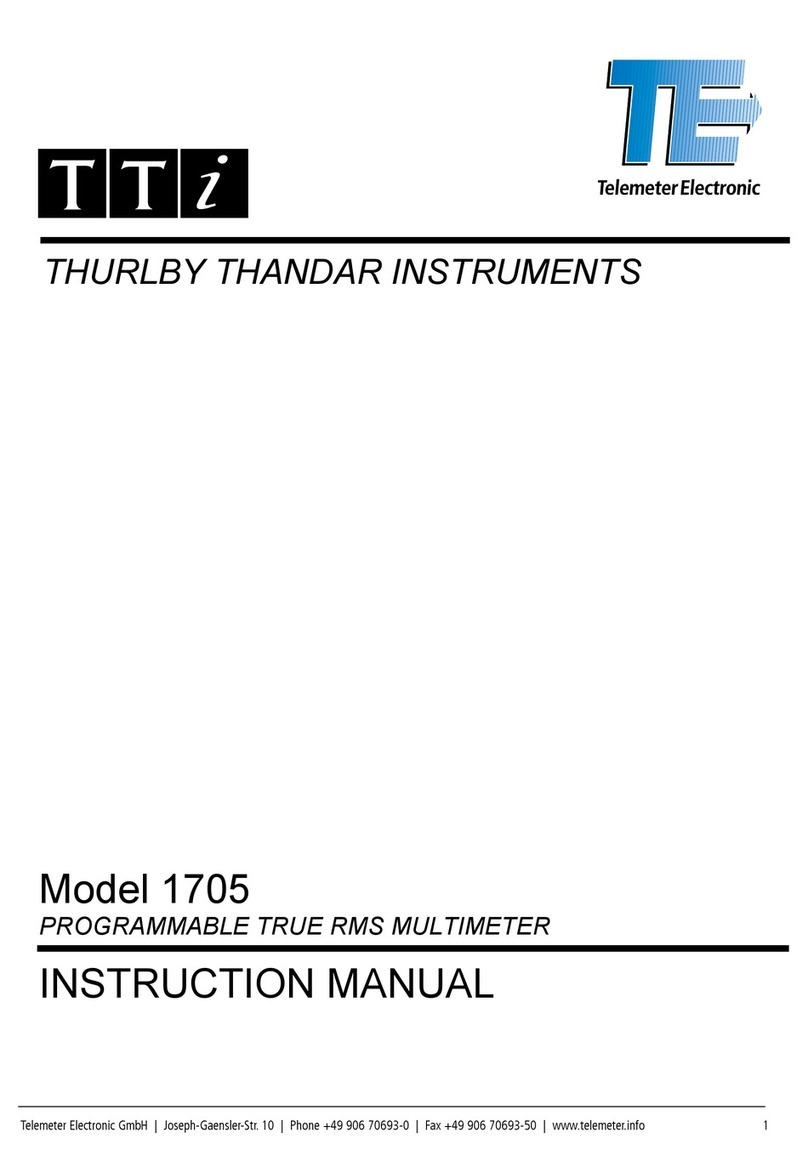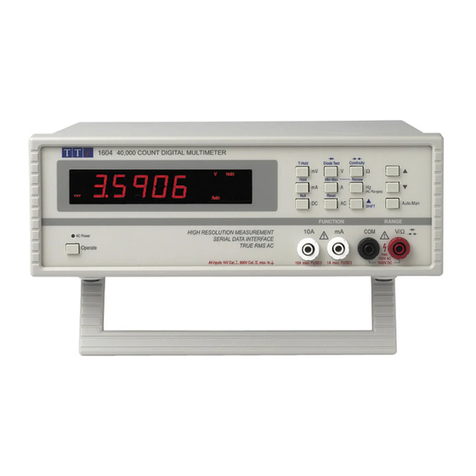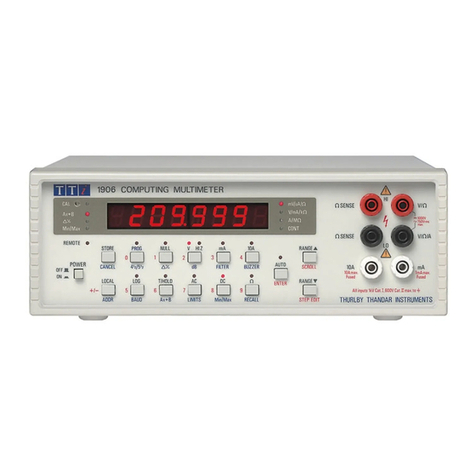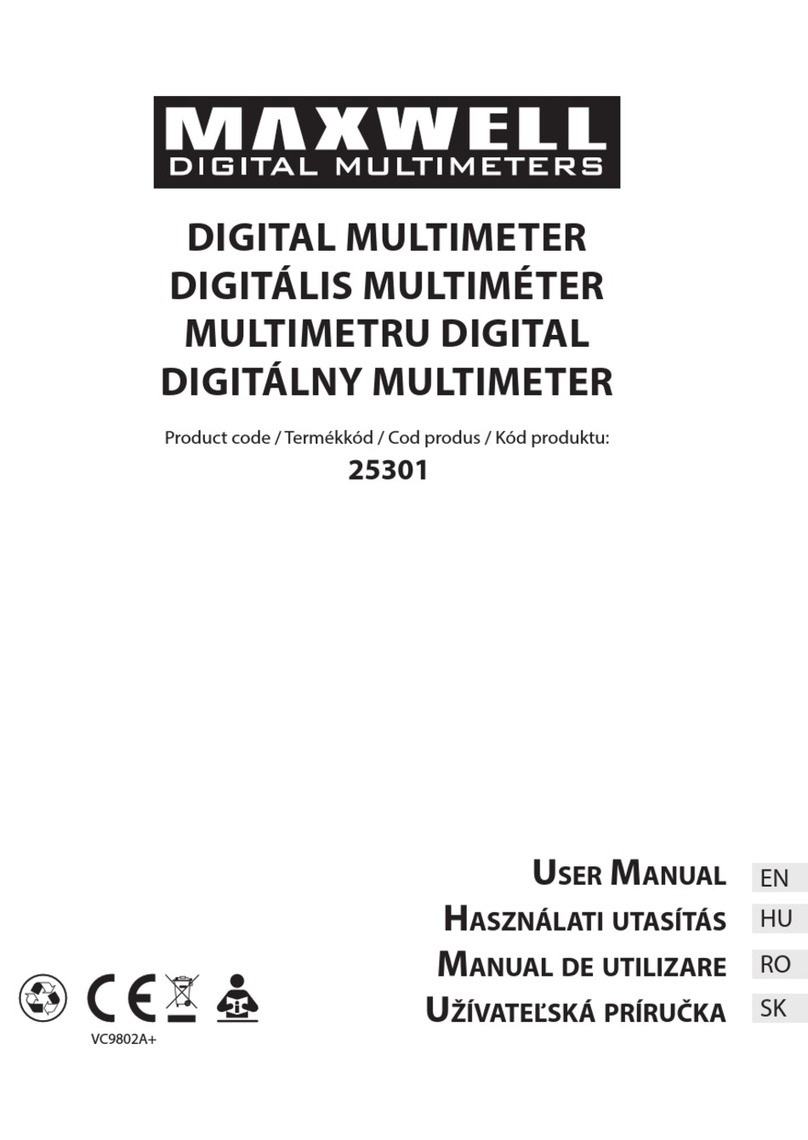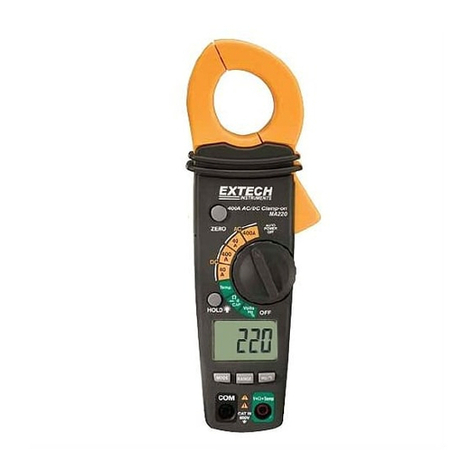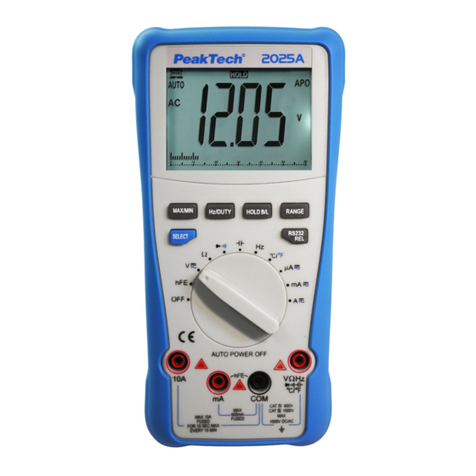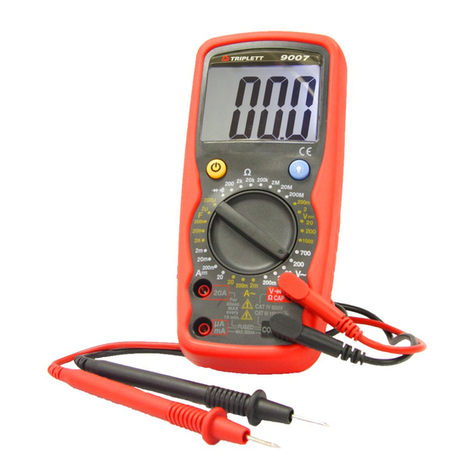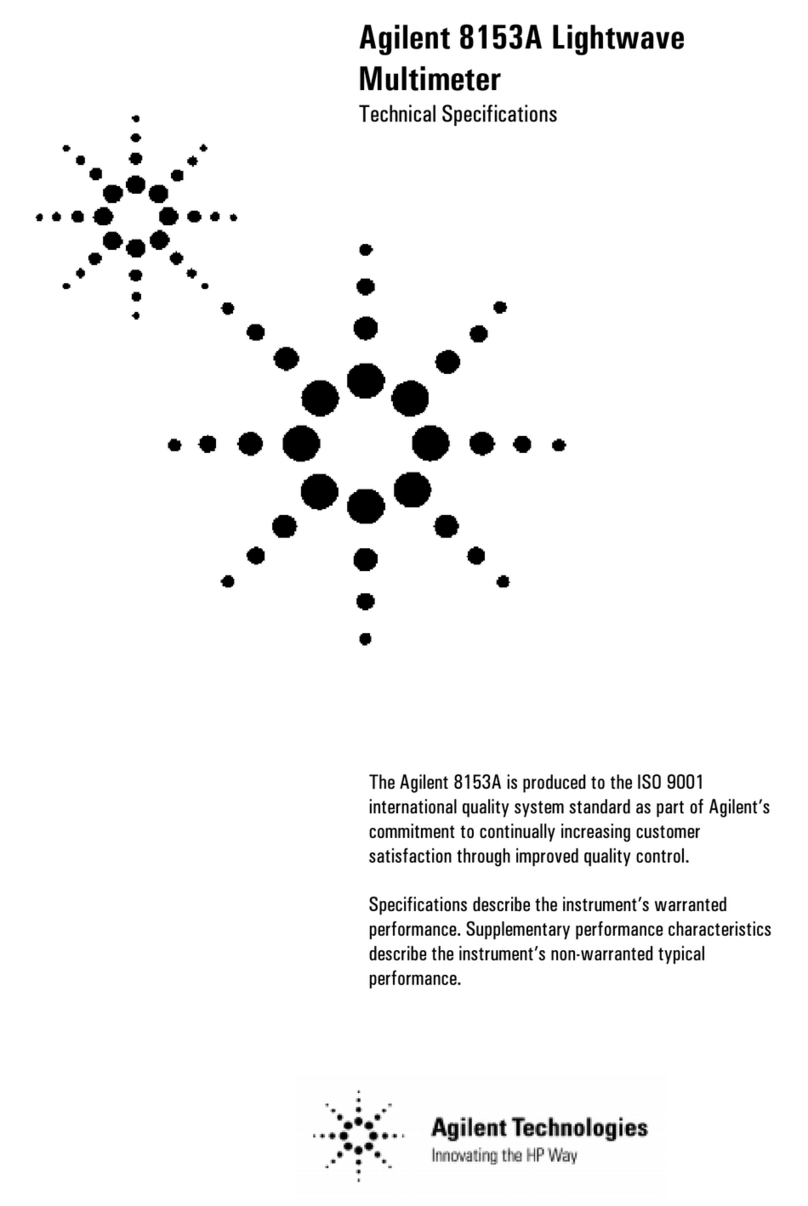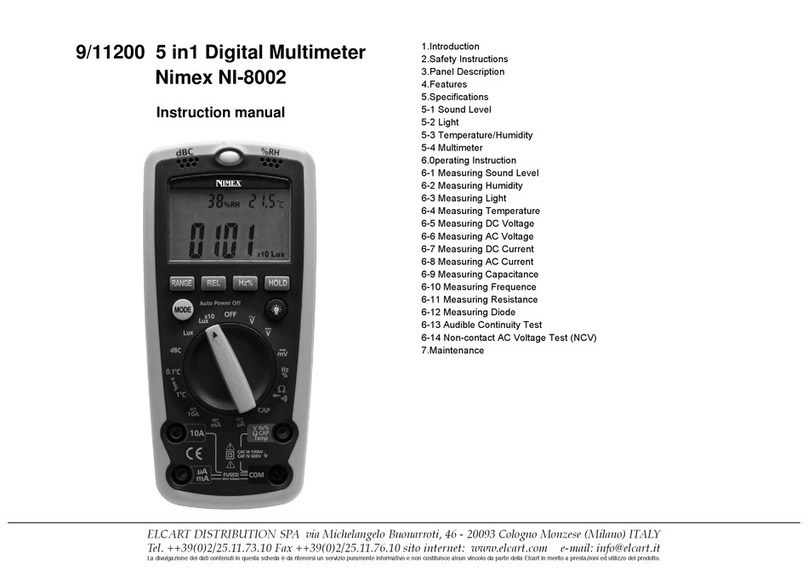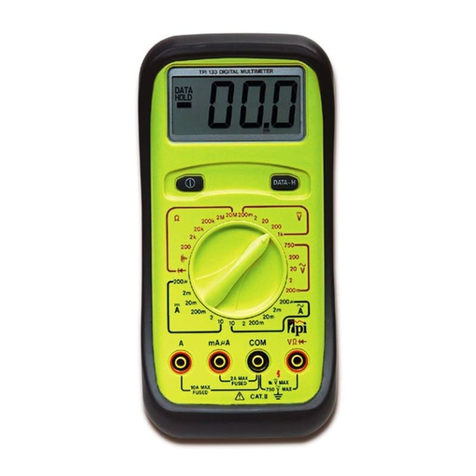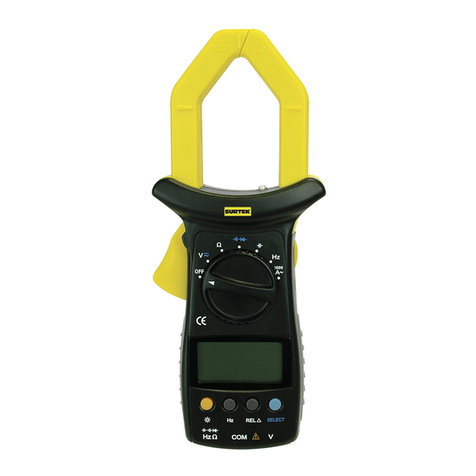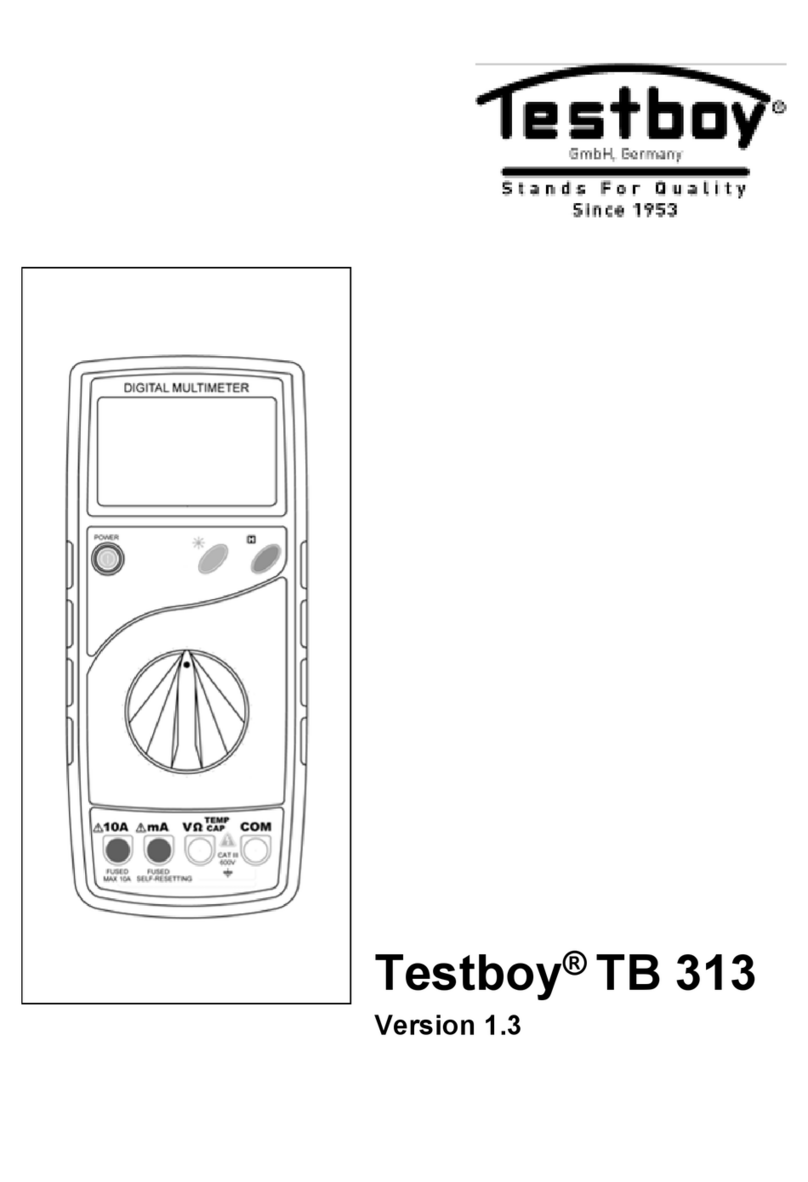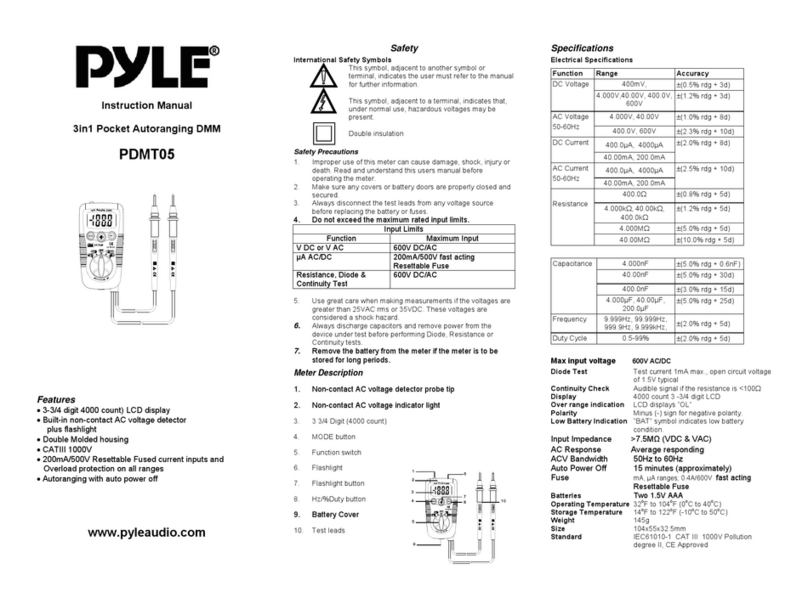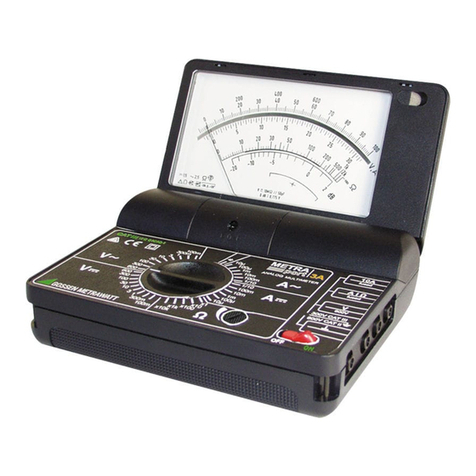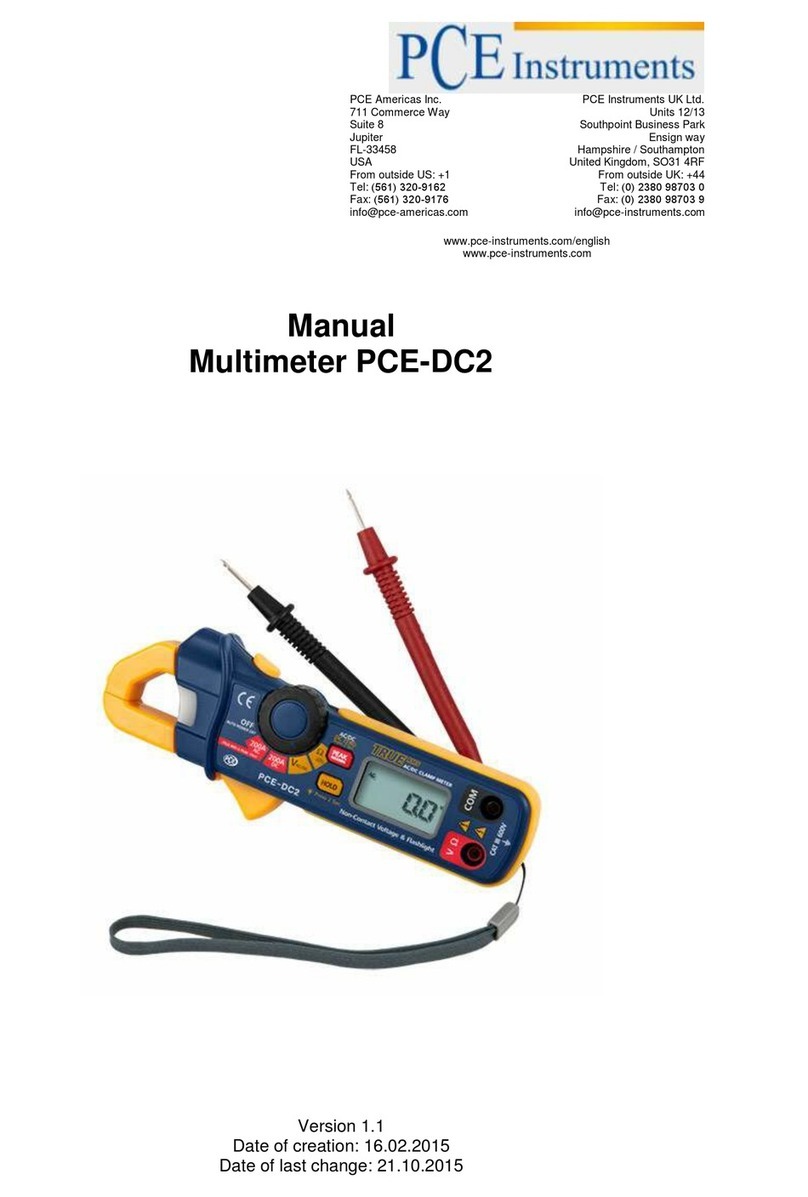TTI 151476 Series User manual

ELECTRICIAN’S MULTIMETER
PART NO: TTIDM1000V (..151476)
OPERATING
INSTRUCTIONS

2ELECTRICIAN’S MULTIMETER
CONTENTS
INTRODUCTION .........................................................................................................3
• Intended Use......................................................................................................................3
• Product Contents ..............................................................................................................3
• Electrical Symbols.............................................................................................................3
GENERAL SAFETY ......................................................................................................4
SAFETY INSTRUCTIONS............................................................................................4
• Safety Standards ...............................................................................................................4
• Safety Instructions............................................................................................................4
GENERAL SPECIFICATIONS......................................................................................6
EXTERNAL OVERVIEW ..............................................................................................6
• Functional Dial Overview ...............................................................................................7
• LCD Screen Overview .......................................................................................................8
• Buttons Overview .............................................................................................................8
OPERATING INSTRUCTIONS ...................................................................................10
• DC Voltage Measurement ...............................................................................................10
• AC Voltage Measurement................................................................................................11
• AC/DC Current Measurement .........................................................................................12
• Resistance Measurement ................................................................................................13
• Diode Measurement.........................................................................................................14
• Continuity Measurement ...............................................................................................16
• Capacitance Measurement ............................................................................................17
• Frequency/Duty Ratio Measurement .........................................................................18
• Temperature Measurement ............................................................................................19
• Transistor Measurement..................................................................................................20
• Non-Contact Voltage Measurement (NCV) ..................................................................21
• Contact Type Live/Neutral Wire Management ............................................................22
TECHNICAL INDEX.....................................................................................................23
• DC Voltage Measurement................................................................................................23
• AC Voltage Measurement................................................................................................23
• Resistance Measurement ................................................................................................24
• Continuity, Diode Measurement....................................................................................24
• Transistor Measurement..................................................................................................25
• Capacitance Measurement .............................................................................................25
• DC Current Measurement................................................................................................25
• AC Current Measurement................................................................................................26
• Frequency/Duty Ratio Measurement............................................................................26
• Temperature Measurement ............................................................................................27
• LED Three Colour Indicator .............................................................................................27
MAINTENANCE...........................................................................................................29
• General Maintenance.......................................................................................................29
• Battery/Fuse Installation and Replacement ...............................................................29
WARRANTY INFORMATION .....................................................................................32

3OPERATING MANUAL
INTRODUCTION
TTIDM1000V is a professional digital multimeter with the following features:
HVAC temperature measurement
Non-contact voltage detection
AC/DC current measurement up to 20A
AC/DC voltage measurement up to 1000V
hFE function
Diode test
INTENDED USE
This multimeter is to be used only for electrical inspection within the specications the
machine is rated for. Failure to use the machine within the specications may result in serious
injury or death.
PRODUCT CONTENTS
Unpack ensure the following attachments are complete or intact.
• TTIDM1000V Multimeter
• Operating instruction manual
• Pair Test Leads
• 4 x 1.5V AAA Batteries
• K-Type thermocouple lead
ELECTRICAL SYMBOLS
AC (alternating current) High voltage hazard
DC (direct current) Grounding
Warning Low battery indicator
Double insulation
This symbol signies
product complies with
Australian requirements

4ELECTRICIAN’S MULTIMETER
GENERAL SAFETY
Prior to using the multimeter, please read the product manual and ensure you have a solid
understanding of the multimeter’s functions and features.
WARNING
!
The warnings, cautions, and instructions discussed in this instruction
manual cannot cover all possible conditions or situations that could
occur. It must be understood by the operator that common sense and
caution are factors that cannot be built into this product, this must be
supplied by the operator.
SAFETY INSTRUCTIONS
SAFETY STANDARDS
•CAT III 600V, CAT II 1000V, double insulation and material pollution grade II.
•CAT safety level: Category III is suitable for measuring circuits connected to the power
distribution section of a buildings low voltage supply unit.
SAFETY INSTRUCTIONS
•Before using the meter inspect the case. Do not use the meter if it is damaged or the case
(or part of the case) is removed. If you can identify cracks or missing parts stop using the
meter immediately.
•Inspect the test leads for damaged insulation or exposed wires. Check test leads
continuity. Replace damaged test leads with leads that are suitable to the meter that meet
or exceed the safety requirements.
•Comply with local and national safety codes. Use personal protective equipment
(approved rubber gloves, face protection, and ame-resistant clothes) to prevent shock
and arc blast injury where hazardous live conductors are exposed.
•Do not apply more than the rated voltage, as marked on the meter, between the terminals
or between any terminal and grounding.
•Limit operation to the specied measurement category, voltage, or amperage ratings.
•Use Product-approved measurement category (CAT), voltage, and amperage rated
accessories (probes, test leads, and adapters) for all measurements.
•Use the correct terminals, function, and range for measurements.
•Before each use, verify meter operation by measuring a known voltage rst.
•Do not touch voltages >30 V ac rms, 42 V ac peak, or 60 V dc.
•Do not use the meter around explosive gas, vapor, or in damp or wet environments
•The function selector should be placed in the right position before using the unit, do
not change the range/function during measurement to avoid damage to the meter or
equipment under test.
•When the meter is working at an eective voltage over 60V in DC or 30V rms in AC, special
care should be taken as there is danger of electric shock.
•Do not touch the probes to a voltage source when the test leads are connected to the
current terminals.

5OPERATING MANUAL
•Connect the common test lead before the live test lead and remove the live test lead
before the common test lead.
•Do not use a current measurement as an indication that a circuit is safe to touch. A voltage
measurement is necessary to know if a circuit is hazardous.
•Do not use the HOLD function to measure unknown potentials. When HOLD is turned on,
the display does not change when a dierent potential is measured.
•When using the test leads, ensure leads are fully seated and keep your ngers behind the
nger guards.
•To avoid electric shock, injury, or damage to the meter, disconnect circuit power and
discharge all high-voltage capacitors before testing resistance, continuity, diodes, or
capacitance.
•Before measuring current, check the meters fuses’and turn o the current to be tested
before connecting the meter to the circuit. After connecting the circuit reliably, turn the
current to be tested on.
•Replace the battery as soon as the battery indicator “ ” appears. With a low battery,
the meter may produce false readings that can lead to electric shock and personal injury.
•Do not alter the meter and use only as specied, or the protection supplied by the meter
can be compromised.
•Use a soft cloth and mild detergent should to clean the surface of the meter when
performing general maintenance. No abrasives or solvents should be used in cleaning;
this is to prevent the surface of the meter from corrosion, damage and accident.
•Turn the meter o when it is not in use. Remove the batteries if the meter is not used for
an extended period of time. If the batteries are not removed, battery leakage may result.
•Repair the meter before use if the battery leaks. Battery leakage may create a shock hazard
or damage the meter.

6ELECTRICIAN’S MULTIMETER
GENERAL SPECIFICATIONS
Max voltage between input terminal and ground: please refer to the technical index for more
details.
20A terminal: 20A 250V fast-acting fuse ( 5x 20mm)
mA/µA terminal: 600mA 250V fast-acting fuse ( 5x20mm)
Display count: 6000
Max capacitance: 100mF
Range: Manual
Polarity: Auto
Refreshes 2-3 times/s; “OL” appears when over-range
Operating temperature: 0°C~40°C (32°F~ 104°F )
Storage temperature: -20°C~60°C (-4°F- 140°F)
Relative humidity: 0°C ~ below 30°C <75%, 30°C~40°C <50%
Operating altitude: 0-2000m
Battery: AAA 1.5V x 4
Low battery indication: LCD displays “ ” symbol
EMC:
a. RF eld {1V/m): overall accuracy= specied accuracy+ 5% of range
b. RF eld (>3V/m): no specied calculation
EXTERNAL OVERVIEW
3.
4.
5.
2.
1.
11.
10.
13.
12.
7.
8.
9.
6.
1. Auto backlight
sensing window
2. LCD screen
3. Functional buttons
4. Function selector
5. Input terminals
6. Hook
7. Multifunctional
test lead slot
8. Flashlight
9. Battery cover screw
10. Case holder
11. NCV sensing part
12. Transistor test ports
13. Audio/visual
alarm indicator

7OPERATING MANUAL
FUNCTIONAL DIAL OVERVIEW
POSITION DESCRIPTION
OFF
Live
NCV
600m
6
60
60
60m
60m
°C°F
Hz%
hFE
600
6k
60k
600k
100mF
6M
60M
60µ
6
600
600
600m
600m
20
20
1000
1000
V
A
V
A
Hz
Hz
VDC voltage measurement
VAC voltage measurement
AAC current measurement
ADC current measurement
Live Contact-type live/neutral wire
measurement
OFF Shut-down
Hz% Frequency/ duty radio measurement
NCV Non-contact voltage measurement
hFE Transistor measurement
ΩResistance measurement
100mF Capacitance measurement
Diode PN junction voltage/
continuity measurement
°C/°F Temperature measurement

8ELECTRICIAN’S MULTIMETER
LCD SCREEN OVERVIEW
SYMBOL DESCRIPTION
DC
AC
Auto
MKΩ
hFE NCV
H
BL
Caution AC/DC voltage is higher
than 30V
Data hold
Negative reading
AC/DC AC/DC measurement
Low battery indicator
Diode measurement
Continuity measurement
Relative value measurement
Ω, k Ω, M Ω Resistance unit
mV, V Voltage unit
μA, mA, A Current unit
nF, μF, mF Capacitance unit
Hz% Frequency unit, duty radio
°C/°F Temperature unit, Celsius/Fahrenheit
βTransistor amplication factor
NCV Non-contact voltage measurement
Live Contact-type live/neutral wire measurement
Auto power o
BL Auto backlight

9OPERATING MANUAL
BUTTONS OVERVIEW
BUTTON DESCRIPTION
SEL
REL
• Continuity/diode: short press (<2s) to cycle
through continuity and diode measurement.
• Hz%: short press (<2s) to cycle through
frequency and duty ratio measurement.
• ACV: short press {<2s) to cycle through
frequency and AC voltage measurement.
• ACA: short press (<2s) to cycle through
frequency and AC current measurement.
• °C°F: short press (<2s) to cycle through Celsius
and Fahrenheit degree measurement.
• NCV: short press {<2s) to cycle through the
sensing range of EFHI and EFLo.
• In the o state, press and hold the SEL/REL
key, then rotate the function dial to turn on
the device. The product enters the non-sleep
mode, and the buzzer produces 5 beeps every
15 minutes, reminding the user to turn o the
product.
• Long press {>2s) REL key to enter/exit REL
measurement mode, LCD will display the REL
symbol (applied to V, mV, uA , mA , A, CAP, Ω
measurement).
OFF
A
• Press to tum on/o the auto backlight
HOLD
• Short press (<2s) and the displayed value will
be locked, and the LCD will display the “ Cl”
symbol ; short press again and the value will be
unlocked. Long press {>2s) this button to turn
on/o the ashlight

10 ELECTRICIAN’S MULTIMETER
OPERATING INSTRUCTIONS
If the battery voltage is low when the device is turned on, “ ”symbol will appear on the
screen. User needs to replace batteries in time before use.
Please also pay special attention to the warning sign “ “ beside the test lead terminals, which
indicates that the tested voltage or current must not exceed the values listed on the device.
SLEEP MODE AND AUTO POWER OFF
If there is no operation for 15 minutes, the meter will automatically shut down to save power.
Before the auto shut-down, the buzzer will make ve consecutive beeps and one long beep
and then enter the sleep state. Pressing any button to exit sleep mode, and the buzzer will beep
once. To disable auto shut-down, switch the function dial to OFF position, long press SEL/REL
button and turn on the meter, the symbol disappears on the LCD with three beeps. Restart
the meter to restore the Auto-o function.
BUZZER WARNING
Input AC/DC voltage >1000V: buzzer warning and red indicator is on, high voltage symbol
appears, indicating that the range is at its limit.
• Current >10A: buzzer warning and the red indicator is on, indicating that the measured
current is relatively large, and the measurement time should be controlled.
• Low battery detection: when the battery is lower than about 4.5V±0.1V, the low battery
symbol “ “ appears.
DC VOLTAGE MEASUREMENT
1. Switch the function selector to Vposition (range: 600mV/6V/60V/600V/1000V).
2. Connect the common test lead to COM terminal, then insert the red test lead into the to
Hz
V Ω°C
terminal.
3. Connect the leads to the correct test points in the circuit to measure voltage.
True RMS
OFF
Live
NCV
600m
6
60
60
60m
60m
°C°F
Hz%
hFE
600
6k
60k
600k
100mF
6M
60M
60µ
6
600
600
600m
600m
20
20
1000
1000
V
Ω
A
V
A
Hz
Hz
°C
mA µA
20A
MAX
FUSED
250V max
600mA max
MAX 10sec EACH 15min
FUSED
250V max
20A max
VΩ
Hz
COM
CAT II 1000V
CAT III 600V
SEL
REL
OFF
A
HOLD
NPN
PNP
E
c
b
e
B
C
TTIDM1000V
V
DC

11OPERATING MANUAL
AC VOLTAGE MEASUREMENT
WARNING
!
Do not input voltage over 1000Vrms. It is possible to measure higher
voltage. However, it may cause damage to the meter. Be cautious to
avoid electric shock when measuring high voltage.
1. Switch the function dial to Vposition (range: 6V/60V/600V/1000V).
2. Connect the common test lead to COM terminal, then insert the red test lead into the to
Hz
V Ω°C
terminal.
3. Connect the leads to the correct test points in the circuit to measure voltage.
NOTE:
•Before using the device, it is suggested to measure a known voltage for verication.
•The meter input impedance is about 10MΩ. This load may cause measurement error when
measuring the high impedance circuit. In most cases, if the circuit impedance is under
10kΩ, the error can be ignored (<:0.1%).
•The input impedance of DC mV scale is innite ( > 1000MΩ), and it does not attenuate
when measuring weak signals, so the measurement accuracy is high. However, when the
test leads are disconnected, there may be a value on the screen, which is normal and will
not aect the measurement result.
•Readings of AC measurement are true RMS.
•At AC voltage position, short press {<2s) SEL/REL button to enter frequency measurement.
Frequency measurement range: 45Hz-1kHz (for reference). Min measurement amplitude:
10% of voltage range.
True RMS
OFF
Live
NCV
600m
6
60
60
60m
60m
°C°F
Hz%
hFE
600
6k
60k
600k
100mF
6M
60M
60µ
6
600
600
600m
600m
20
20
1000
1000
V
Ω
A
V
A
Hz
Hz
°C
mA µA
20A
MAX
FUSED
250V max
600mA max
MAX 10sec EACH 15min
FUSED
250V max
20A max
VΩ
Hz
COM
CAT II 1000V
CAT III 600V
SEL
REL
OFF
A
HOLD
NPN
PNP
E
c
b
e
B
C
TTIDM1000V
V
AC

12 ELECTRICIAN’S MULTIMETER
AC/DC CURRENT MEASUREMENT
WARNING
!
• To prevent possible electric shock, re or personal injury, switch o
the power supply of the circuit before measuring the current, and then
connect the meter with the circuit in series.
• Use the proper terminals, switch position, and range for your
measurement. If the range of the measured current is unknown, select
the maximum range and then accordingly reduce.
• There are fuses built in to the 20A and mA/µA terminals. Never place
the probes in parallel with a circuit or component when the leads are
plugged into these A (Amps) terminals.
Switch the function selector to Aposition the green indicator should be on.
1. According to the current being measured, connect the common test lead to COM terminal,
then insert the red test lead to mAµA or 20A terminal
2. Connect the test leads with the circuit in series.
NOTE:
•Readings of AC measurement are true RMS.
•If the tested current is 6A~10A, the Max measurement time should not exceed 60 seconds,
and the next test should be after 1 minute.
•If the tested current is >10A, the Max measurement time should not exceed 10 seconds,
and the next test should be after 15 minutes.
•When measuring AC current, short press (<2S) SEL/REL button to display AC frequency.
True RMS
OFF
Live
NCV
600m
6
60
60
60m
60m
°C°F
Hz%
hFE
600
6k
60k
600k
100mF
6M
60M
60µ
6
600
600
600m
600m
20
20
1000
1000
V
Ω
A
V
A
Hz
Hz
°C
mA µA
20A
MAX
FUSED
250V max
600mA max
MAX 10sec EACH 15min
FUSED
250V max
20A max
VΩ
Hz
COM
CAT II 1000V
CAT III 600V
SEL
REL
OFF
A
HOLD
NPN
PNP
E
c
b
e
B
C
TTIDM1000V
AC/DC

13OPERATING MANUAL
RESISTANCE MEASUREMENT
WARNING
!
• To avoid damaging the meter or to the device under test, disconnect
circuit power and discharge all the high-voltage capacitors before
measuring resistance.
• To avoid electric shock, do not input higher than DC 60V or AC 30V
voltages.
1. Switch the function selector to Ωposition (range: 600Ω/6kΩ/60kΩ/600MΩ/60MΩ), make
sure the circuit power is turned o.
2. Connect the common test lead to COM terminal then insert the red test lead to Hz
V Ω°C
terminal.
3. Connect the leads to the correct test points in the circuit to measure voltage.
NOTE:
•If the measured resistor is open or the resistance exceeds the maximum range, the “OL”
symbol will be displayed on the screen.
•When measuring low resistance, the test leads will produce 0.1Ω-0.3Ω measurement error. To
obtain accurate measurement, short-circuit the test leads and use the REL function.
•If the resistance is greater than 0.5Ω when the test leads are shorted, please check if the test
leads are loose or damaged.
•When measuring high resistance at 60MΩ range, it takes a few seconds to stabilise the
readings.
•The internal 600mA and 20A fuses can be checked by the 6MΩ measurement function.
Please refer to Picture 5b for more details: Insert the red probe to the 630mA or 20A input
terminal to measure the resistance. If both fuses are blown, the“OL”symbol will appear on
the screen.
R
True RMS
OFF
Live
NCV
600m
6
60
60
60m
60m
°C°F
Hz%
hFE
600
6k
60k
600k
100mF
6M
60M
60µ
6
600
600
600m
600m
20
20
1000
1000
V
Ω
A
V
A
Hz
Hz
°C
mA µA
20A
MAX
FUSED
250V max
600mA max
MAX 10sec EACH 15min
FUSED
250V max
20A max
VΩ
Hz
COM
CAT II 1000V
CAT III 600V
SEL
REL
OFF
A
HOLD
NPN
PNP
E
c
b
e
B
C
True RMS
OFF
Live
NCV
600m
6
60
60
60m
60m
°C°F
Hz%
hFE
600
6k
60k
600k
100mF
6M
60M
60µ
6
600
600
600m
600m
20
20
1000
1000
V
Ω
A
V
A
Hz
Hz
°C
mA µA
20A
MAX
FUSED
250V max
600mA max
MAX 10sec EACH 15min
FUSED
250V max
20A max
VΩ
Hz
COM
CAT II 1000V
CAT III 600V
SEL
REL
OFF
A
HOLD
NPN
PNP
E
c
b
e
B
C
TTIDM1000V TTIDM1000V

14 ELECTRICIAN’S MULTIMETER
DIODE MEASUREMENT
WARNING
!
• To avoid possible damage to the meter and to the device under test,
disconnect circuit power and discharge all high-voltage capacitors
before testing diodes.
• To avoid electric shock, do not input higher than DC 60V or AC 30V
1. Switch the function selector to position.
2. Short press (<2s) SEL/REL button to activate the diode measurement.
3. Connect the common test lead to COM terminal, then insert red test lead to Hz
V Ω°C
terminal.
4. Connect the red probe to diode anode, black to diode cathode.
5. Reading <0.12V: red indicator will be on with continuous beeps, indicating the diode may
break down; Reading within 0.12V-2V: green indicator will be on with one beep, indicating
the diode is in good condition (for reference).
6. If the diode is open or its polarity is reversed, the “OL” symbol will appear on the screen.
7. Silicon PN junction: about 500-800mV (normal value).

15OPERATING MANUAL
True RMS
OFF
Live
NCV
600m
6
60
60
60m
60m
°C°F
Hz%
hFE
600
6k
60k
600k
100mF
6M
60M
60µ
6
600
600
600m
600m
20
20
1000
1000
V
Ω
A
V
A
Hz
Hz
°C
mA µA
20A
MAX
FUSED
250V max
600mA max
MAX 10sec EACH 15min
FUSED
250V max
20A max
VΩ
Hz
COM
CAT II 1000V
CAT III 600V
SEL
REL
OFF
A
HOLD
NPN
PNP
E
c
b
e
B
C
TTIDM1000V
True RMS
OFF
Live
NCV
600m
6
60
60
60m
60m
°C°F
Hz%
hFE
600
6k
60k
600k
100mF
6M
60M
60µ
6
600
600
600m
600m
20
20
1000
1000
V
Ω
A
V
A
Hz
Hz
°C
mA µA
20A
MAX
FUSED
250V max
600mA max
MAX 10sec EACH 15min
FUSED
250V max
20A max
VΩ
Hz
COM
CAT II 1000V
CAT III 600V
SEL
REL
OFF
A
HOLD
NPN
PNP
E
c
b
e
B
C
TTIDM1000V
True RMS
OFF
Live
NCV
600m
6
60
60
60m
60m
°C°F
Hz%
hFE
600
6k
60k
600k
100mF
6M
60M
60µ
6
600
600
600m
600m
20
20
1000
1000
V
Ω
A
V
A
Hz
Hz
°C
mA µA
20A
MAX
FUSED
250V max
600mA max
MAX 10sec EACH 15min
FUSED
250V max
20A max
VΩ
Hz
COM
CAT II 1000V
CAT III 600V
SEL
REL
OFF
A
HOLD
NPN
PNP
E
c
b
e
B
C
TTIDM1000V
True RMS
OFF
Live
NCV
600m
6
60
60
60m
60m
°C°F
Hz%
hFE
600
6k
60k
600k
100mF
6M
60M
60µ
6
600
600
600m
600m
20
20
1000
1000
V
Ω
A
V
A
Hz
Hz
°C
mA µA
20A
MAX
FUSED
250V max
600mA max
MAX 10sec EACH 15min
FUSED
250V max
20A max
VΩ
Hz
COM
CAT II 1000V
CAT III 600V
SEL
REL
OFF
A
HOLD
NPN
PNP
E
c
b
e
B
C
TTIDM1000V
Indicator
Good diode (forward bias) Good diode (reverse bias)
Bad diode (open) Bad diode (shorted)
Indicator
Indicator
Indicator
BL
BL
BL
BL

16 ELECTRICIAN’S MULTIMETER
CONTINUITY MEASUREMENT
WARNING
!
• To avoid damaging the meter or to the device when testing, disconnect
circuit power and discharge all the high-voltage capacitors before
testing for continuity.
• To avoid electric shock, do not input higher than DC 60V or AC 30V
1. Switch the function dial to the position, and make sure the circuit power is turned
o.
2. Connect common test lead to COM terminal, then insert the red test lead to Hz
V Ω°C
terminal.
3. Connect the probes to the circuit test points.
4. Measured resistance >30Ω : The circuit is broken; buzzer makes no sound;
red indicator is on.
Measured resistance, <30Ω: The circuit is in good conduction status; buzzer beeps
continuously; green indicator is on.
If “OL“ appears on the screen, the circuit is in open status.
R
True RMS
OFF
Live
NCV
600m
6
60
60
60m
60m
°C°F
Hz%
hFE
600
6k
60k
600k
100mF
6M
60M
60µ
6
600
600
600m
600m
20
20
1000
1000
V
Ω
A
V
A
Hz
Hz
°C
mA µA
20A
MAX
FUSED
250V max
600mA max
MAX 10sec EACH 15min
FUSED
250V max
20A max
VΩ
Hz
COM
CAT II 1000V
CAT III 600V
SEL
REL
OFF
A
HOLD
NPN
PNP
E
c
b
e
B
C
TTIDM1000V

17OPERATING MANUAL
CAPACITANCE MEASUREMENT
WARNING
!
Please fully discharge all capacitors before measuring (especially
for capacitors with high voltage) to avoid damage to the meter
and personal injury.
1. Switch the function dial to 100mF position, the green indicator should be on.
2. Connect the common test lead to COM terminal, then insert red test lead to Hz
V Ω°C
terminal.
3. Connect the probes to the pins of capacitor.
4. When measuring large volume capacitor, if the yellow indicator is on, it indicates that the
capacitor is being charged, and the green indicator will be on when the capacitor is fully
charged, then wait for the steady reading.
NOTE:
•If the measured capacitor is short-circuited or the capacitance exceeds the maximum
range, the“OL”symbol will appear on the screen.
•When measuring large volume capacitors, it may take a few seconds to obtain steady
readings.
•When there is no input, the meter displays a xed value (intrinsic capacitance).
•For small capacitance measurement, this xed value must be subtracted from the
measured value to ensure measurement accuracy. Or users can choose the relative
measurement function (REL) to automatically subtract the intrinsic capacitance.
True RMS
OFF
Live
NCV
600m
6
60
60
60m
60m
°C°F
Hz%
hFE
600
6k
60k
600k
100mF
6M
60M
60µ
6
600
600
600m
600m
20
20
1000
1000
V
Ω
A
V
A
Hz
Hz
°C
mA µA
20A
MAX
FUSED
250V max
600mA max
MAX 10sec EACH 15min
FUSED
250V max
20A max
VΩ
Hz
COM
CAT II 1000V
CAT III 600V
SEL
REL
OFF
A
HOLD
NPN
PNP
E
c
b
e
B
C
TTIDM1000V
100mF

18 ELECTRICIAN’S MULTIMETER
FREQUENCY/DUTY RATIO MEASUREMENT
WARNING
!Do not input voltage higher than DC 60V or AC 30V to avoid
personal injury!
1. Switch the function selector to Hz% position the green indicator should be on.
2. Connect the common test lead to COM terminal, then insert red test lead to Hz
V Ω°C
terminal.
3. The frequency value is displayed on the screen.
4. Short press (<2s) SEL/REL button to perform duty ratio measurement.
5. When measuring AC voltage or AC current, you can short press (<2s) the SEL/REL button to
switch to frequency measurement.
True RMS
OFF
Live
NCV
600m
6
60
60
60m
60m
°C°F
Hz%
hFE
600
6k
60k
600k
100mF
6M
60M
60µ
6
600
600
600m
600m
20
20
1000
1000
V
Ω
A
V
A
Hz
Hz
°C
mA µA
20A
MAX
FUSED
250V max
600mA max
MAX 10sec EACH 15min
FUSED
250V max
20A max
VΩ
Hz
COM
CAT II 1000V
CAT III 600V
SEL
REL
OFF
A
HOLD
NPN
PNP
E
c
b
e
B
C
TTIDM1000V
Hz%

19OPERATING MANUAL
TEMPERATURE MEASUREMENT
1. Switch the function dial to °C°F position.
2. Plug the K-type thermocouple“+” end to Hz
V Ω°Cterminal and the other end to
COM terminal.
3. Short press (<2s) SEL/REL button to switch between°C°F.
NOTE:
•“OL”symbol appears when the meter is turned on.
•°F=1.8x°C+32
True RMS
OFF
Live
NCV
600m
6
60
60
60m
60m
°C°F
Hz%
hFE
600
6k
60k
600k
100mF
6M
60M
60µ
6
600
600
600m
600m
20
20
1000
1000
V
Ω
A
V
A
Hz
Hz
°C
mA µA
20A
MAX
FUSED
250V max
600mA max
MAX 10sec EACH 15min
FUSED
250V max
20A max
VΩ
Hz
COM
CAT II 1000V
CAT III 600V
SEL
REL
OFF
A
HOLD
NPN
PNP
E
c
b
e
B
C
TTIDM1000V
°C°F

20 ELECTRICIAN’S MULTIMETER
TRANSISTOR MEASUREMENT
WARNING
!Do not input any voltage at any test lead terminals during the
transistor measurement to avoid personal injury!
1. Switch the function selector to hFE position, make sure that the lest leads aren’t connected
to any circuit
2. Insert the three pins of the transistor to the socket according to the polarity
3. The reading on the screen is the amplication factor of the measuring transistor.
– Amplication factor >50: green indicator is on, indicates the amplication is good.
– Amplication factor <50: yellow indicator is on, indicates the amplication is poor.
True RMS
OFF
Live
NCV
600m
6
60
60
60m
60m
°C°F
Hz%
hFE
600
6k
60k
600k
100mF
6M
60M
60µ
6
600
600
600m
600m
20
20
1000
1000
V
Ω
A
V
A
Hz
Hz
°C
mA µA
20A
MAX
FUSED
250V max
600mA max
MAX 10sec EACH 15min
FUSED
250V max
20A max
VΩ
Hz
COM
CAT II 1000V
CAT III 600V
SEL
REL
OFF
A
HOLD
NPN
PNP
E
c
b
e
B
C
TTIDM1000V
Indicator
This manual suits for next models
1
Table of contents
Other TTI Multimeter manuals
